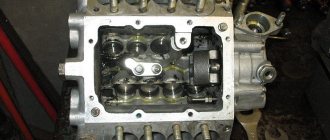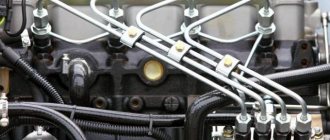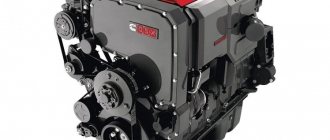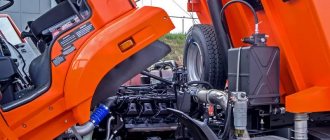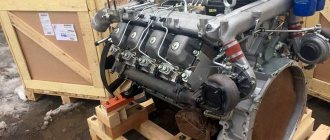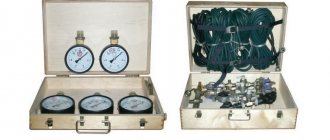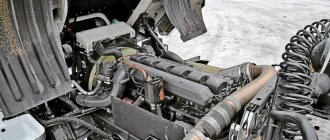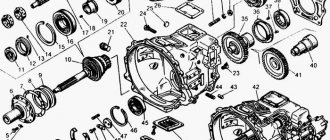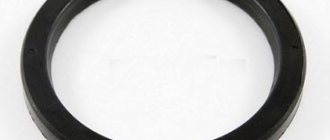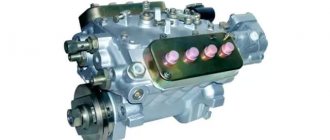During operation of an internal combustion engine, a large amount of heat is generated, some of which is removed by the standard cooling system. Some parts that operate under intense temperature conditions (crankshaft, connecting rods, pins, etc.) are cooled by the oil of the engine lubrication system, which must also release the resulting heat to the surrounding air. The KamAZ liquid-oil heat exchanger (LHT) is designed for these purposes.
What does a liquid-oil heat exchanger consist of and how does it work?
Inside the body of the aluminum part there is a core with a deflector and oil filters, from which inlet and outlet pipes for pumping coolant extend. The inlet pipe (manifold) is responsible for supplying coolant from the cylinder block for cooling, and the outlet pipe is responsible for returning the coolant back to the water jacket. Also, an important design element is a bypass valve for emergency operation bypassing the deflector in case of clogging or other problems in operation.
The core is divided by metal plates into 4 isolated sections. Their presence allows you to direct the flow of oil and coolant inside the operating system. This is also what the flange does, tightly fixed inside the housing with o-rings at one end and resting against the end wall at the other. The deflector is responsible for directing the flow of engine oil in the design.
Despite all the apparent complexity, the main task of the part is to effectively separate the oil and refrigerant flows when distilling them inside a closed loop. Accordingly, the refrigerant is “locked” inside the core tubes, and the oil, which needs more space and flow path, seeps between the tubes with the refrigerant and the walls of the LMC housing. The inlet manifold is connected to the system through a short adapter tube, and the outlet manifold is connected by clamping.
The operating principle of a liquid-oil cooler in general looks like this:
when the engine heats up to 95–100 degrees, the thermal power valve of the LMC opens;
through the valve, part of the oil from the filters enters the casing;
inside, the oil passes through all 4 core blocks, giving off heat and cooling in the process;
the cooled oil gradually returns to the system through the outlet manifold.
If the engine overheats to 100–115 degrees, the entire oil flow from the system passes through the heat exchanger. LMC is effective at engine heating temperatures up to 115 degrees. In case of overheating, an emergency indicator starts flashing on the KAMAZ dashboard, signaling the need to turn off the engine until it cools completely and perform diagnostics of the system to find the reason for reaching a critical temperature level.
Why do malfunctions occur in the operation of liquid metal parts?
The oil in the engine not only cools, but also cleans it from the inside. Not all accumulated particles of soot, soot, and spent impurities remain on the oil filters; some of them settle in the heat exchanger core. Gradually, the space between the tubes and plates becomes clogged, the oil flow deteriorates, and along with it, the cooling efficiency decreases. If the part was not removed and cleaned in time, over time it will become completely clogged and the oil flow will bypass the core through the bypass valve.
The corresponding indicator on the KAMAZ dashboard will indicate that the system is clogged, but it is better not to wait for an alarm signal. Regular cleaning will help prevent the casing from clogging. The frequency of flushing to remove dirt deposits in engine oil depends on the intensity of use of the vehicle. Under moderate loads, this should be done simultaneously with changing the engine oil; under heavy loads, this should be done 2–3 times more often.
Before flushing, as well as before repairs, it is advisable to empty the liquid-oil heat exchanger: drain the coolant and part of the oil. When finished, the fluid should be topped up to the recommended level. It is especially important to ensure that the gearbox and engine are full of oil, because due to lack of lubrication and proper cooling, these components are the first to become unusable.
Over time, even with proper maintenance, car parts wear out. In the case of a heat exchanger, the sealing elements are the first to deteriorate, then cracks and crevices appear on the metal elements inside the casing. If the seal is defective, it can be replaced; for this purpose, there is a wide selection of repair kits with cores, gaskets, and spare manifolds on sale. If serious damage to the housing and internal tubes is detected, it is advisable to replace the part with a new one.
The design of the KamAZ heat exchanger and features of its repair
During operation of an internal combustion engine, a large amount of heat is generated, some of which is removed by the standard cooling system. Some parts that operate under intense temperature conditions (crankshaft, connecting rods, pins, etc.) are cooled by the oil of the engine lubrication system, which must also release the resulting heat to the surrounding air. The KamAZ liquid-oil heat exchanger (LHT) is designed for these purposes.
Standard electrical sensor
On engines, KamAZ 740.31.240, vehicles KamAZ-43118, 43114, etc., the MM370 product is used as a standard lubricant pressure measuring device. This control mechanism is produced in the city of Vladimir. Visually, the device is a cylinder with a threaded connection at the bottom. The thread connects the part to the working area of the lubrication system. The top part is used to connect wires.
Lubricant pressure meter for KamAZ MM-370 vehicle:
Technical characteristics of the electrical device MM-370
| Index | Meaning |
| Length, mm. | 70 |
| Cylinder, section, mm. | 40 |
| Threaded connection | M14 by 1.5 |
| Hexagon, mm | 19 |
| Pressure range, kgf/cm 2 | 0-10 |
| Resistance, Ohm | 159-173 |
Design and principle of operation
When a car engine is running, the oil heats up along with the parts. The more powerful the engine, the more heat is generated and the higher the oil temperature rises. When the limit values of this parameter are reached, the properties of the lubricating fluid are lost, which leads to failure of the elements and the entire motor. Heat exchangers are used to remove excess heat from the oil in the lubrication system.
KamAZ trucks are equipped with shell-and-tube (tubular) LMCs. They consist of a cast aluminum body and core. The latter is a bundle of thin-walled tubes, in most cases copper, flared into flanges, which at the same time serve as end caps for the oil cavity. To increase the heat transfer area, the outer side of the tubes has fins made in the form of plates.
Cooling system antifreeze circulates inside the tubes. Oil is supplied through flanges into the heat exchanger housing. Thanks to the installed partitions, it crosses the tube bundle 4 times, which greatly increases the efficiency of cooling the medium. Due to the fact that the oil temperature cannot be lower than the temperature of the cooling system fluid, this reduces the thermal stress of the lubricated parts.
The heat exchanger is installed on the housing of the filter unit. It contains a thermal valve (thermostat) for connecting the heat exchanger. At a temperature of +93°C and below, the main flow of oil passes by the liquid solids. Increasing the parameter above +95°C leads to movement of the thermal valve piston. The flow of working fluid from the lubrication system is directed to the heat exchanger. At a temperature of +115°C, the oil overheats, which is indicated by a red indicator located on the driver’s instrument panel. After this, the machine must be stopped and measures taken to bring the parameter values back to normal.
Replacing the control device
Dismantling and installing new equipment is not difficult thanks to the convenient location of the sensor. When carrying out manipulations, perform the following actions:
- Turn off the ignition of the power plant, open the hood of the car;
- Remove the hose from the sensor and remove the product from the holder;
- Treat the mounting socket with a sealed solution, install a new device;
- Connect the hose to the sensor, having previously coated it with a sealed solution;
- Connect the hose to the pressure gauge.
Daily monitoring of oil level, fluid pressure, fuel quality is an indispensable condition for the normal operation of the KamAZ power plant. The procedures performed are not difficult, so they are carried out by drivers of any qualification. At the same time, neglecting these simple manipulations will lead to serious and irreparable consequences, which are easier to prevent than to eliminate.
How to remove and disassemble
To carry out scheduled maintenance or eliminate a defect, the liquid metal parts must be dismantled. It is difficult to remove the heat exchanger on a KamAZ truck with your own hands, but it is possible. To do this, it is necessary to dismantle the components that interfere with free access to the device. Then the water pipes are disconnected and only after that the oil pipes. All openings on the engine are covered with a clean rag to prevent dirt from getting into the cavities.
Disassembling the heat exchanger involves dismantling the core for subsequent cleaning or eliminating defects that have arisen. After dismantling, be sure to remove it, and if that doesn’t work, scrape off the old paronite gaskets from the flanges. It must be remembered that there may be antifreeze left in the tubes, and oil residues in the housing. The removed heat exchanger is inspected for cracks and contamination of the cooling surface.
Where is the pressure sensor located on KamAZ?
The design of the measuring device is simple:
- Casing made of steel;
- Elastic membrane;
- Stock;
- Contacts.
KamAZ lubricant pressure sensor:
Regardless of what type of meter KamAZ uses, the mounting of the products is standard. As a rule, the oil pressure sensor is installed on a KamAZ truck on the frame of the power unit, on the bracket where the oil filter element is located.
Repair
The main malfunctions of the heat exchanger are loss of tightness of the tube bundle and a decrease in the power of the device due to silting of the flow part of one or both cavities. In case of such breakdowns, the functionality of the device is restored by cleaning, welding or plugging the tubes. However, sometimes defects arise when their elimination is impractical. In such a situation, an aggregate replacement of liquid metal parts is carried out.
In most cases, a leak in a pipe system occurs in the area where the heat exchange tubes are attached to the end flanges. Signs of a leak are the appearance of an oil suspension in the engine cooling system. The locations of detected defects are sealed. If the fistula appears in the tube itself, then it is plugged. No more than 10% of the cooling elements are allowed to be taken out of service. After the malfunction is eliminated, the heat exchanger is pressurized, thereby checking the quality of the work performed.
In most cases, descaling of tubes is carried out mechanically using a roller cutter or special screw attachments installed in a drill. If it is impossible to clean the liquid solids in this way, chemical washing is carried out using washing liquids. To do this, use a 5% aqueous solution of hydrochloric acid. The core is soaked in it and left in this state for 30-40 minutes. After this, the part is thoroughly washed in a 3% sodium bicarbonate solution.
Cleaning is carried out until the dirt is removed. After this, the core is washed with hot water and dried well (blown with air).
Many drivers believe that if the device loses its tightness or leaks in the tubes, the heat exchanger needs to be replaced with a working one, because After some time, the same defect occurs again.
During any disassembly of LMC, it is necessary to install only new gaskets.
How to install
The heat exchanger is assembled after receiving positive results from the defect elimination test. Before installing the device in its original location, it is necessary to prepare the mounting surfaces of the oil system on the filter block. To do this, remove the remains of old seals and clean the flanges. Paronite gaskets are installed with grease and the fastening bolts are tightened. The use of sealant is not recommended.
After installing the LMC in its normal place, it is connected to the engine cooling system. After this, the oil and water cavities are filled with working media. Then the engine is started and the absence of leaks and the operating parameters of the systems being repaired are checked. After the inspection, the heat exchanger repair is considered complete.
Possible faults
Any system has its weak points that need to be checked. If you diagnose a minor breakdown in time, you can avoid further major problems. The driver can visually identify most faults independently.
- Antifreeze leak. This type of malfunction is so noticeable that the driver’s main task is to look under the hood more often. The malfunction will be expressed by smudges and spots corresponding to the color of the coolant. A leak is possible due to the tank being incomplete or overflowing. The most vulnerable spot is the connection of the pipes. Leaks can also occur due to destruction (wear) of rubber hoses. Therefore, it is the pipes that are considered the weak point. To eliminate a leak, you need to carefully check whether all fixing bolts are tightened and perform a pressure test.
- Coolant overheating is a complex problem of poor operation of the entire unit. Reaching more than ninety-five degrees, the antifreeze will boil, so you need to better monitor the temperature.
- Hypothermia, similar to overheating, disrupts the integrity of a group of mechanisms. Too low a temperature prevents the engine from starting correctly. When running “cold,” the engine idles longer; some drivers call this problem “snatching air,” in other words, the system for pumping air masses inside the blocks also begins to malfunction. An important point is in what position the valve jams. If the “O” position is open, then the coolant will “walk” in a large circle through the radiator, preventing the cold engine from warming up.
- The most serious problem is coolant getting inside the oil system.
The cooling system must always be sealed. A visual inspection will not help identify the “background” areas, so it is better to stock up on a pressure gauge or a pump to create pressure. Pressure testing is carried out by applying pressure to the upper inlet of the radiator with a pump, after which the engine starts, the readings are checked with a pressure gauge. If the arrow remains unchanged, then the pressure inside is good and there are no gaps. If the needle starts to drop, all that remains is to find the problem area, which can then be pressurized with a pressure pump.
The coolant is replaced if the tank is very dirty, or the consistency has changed and the cooling properties are lost. The filling capacity of Kamaz is 25 liters.
Firstly, the old antifreeze is drained. We open the lower radiator valve, the drain valve of the heating system heat exchanger, and the fluid supply pipes of the cabin heating system. Unscrew the expansion tank cap. After draining the coolant, all taps are closed back, because filling occurs through the expansion tank. New antifreeze should be selected based on the time of year, operating conditions, and manufacturer’s recommendations. Modern domestic antifreezes are perfect for Kamaz vehicles, having the necessary quality standards.
If there is just minor dust contamination, the system can be flushed with plain water. To do this, drain the old fluid, fill it with water, start the engine, warming it up at idle speed. After this, drain the water, repeating the cycle until completely clean. For severe contamination, it is better to use special washes. Some can be added directly to the existing antifreeze, but the best way is to flush the flushing system, before which the coolant is completely drained.
Features of the KAMAZ heat exchanger
When the oil heats up, complex processes occur that can negatively affect the functioning of the engine. The viscosity of the consumable fluid changes, which leads to its burnout and splitting. The vehicle's performance drops sharply. Heated oil is not able to provide lubrication to contacting elements and mechanisms and does not allow the engine to cool properly. This often causes the power unit of KAMAZ special equipment to jam.
The role of lubrication in the engine
Before considering the device and types of sensors, let’s figure out whether lubrication in the engine is so important. When calculating the power plant, designers make the surfaces of components and mechanisms as strong as possible. This helps to increase the life of the unit and the quality of its functions. Since the products are in contact with each other, the frictional force that arises between them leads to wear on the mechanisms. Lubricating parts is the only way to combat friction.
Oil circulation through channels under pressure is a condition for performing the assigned functions. A way to check the correctness of the indicators is an oil pressure sensor, similar to the device installed on the KamAZ 740.
Maintaining the performance and functionality of the motor, the lubricant does:
- Coating the surfaces of parts with an even layer of oil;
- Removal of some heat;
- Removing dirt and abrasive particles;
- Anti-oxidation;
- Strengthening the connection and connection of parts;
- Acting as a working body.
It is taken into account that the pressure value is controlled in an installation heated to a temperature of 70°C. Normal KamAZ engine speed is 2600 min-1. The standard pressure value is 0.45-0.5 MPa.
Dismantling the KAMAZ heat exchanger
Replacement of the unit is required in cases of damage to the housing, burnout of gases, leakage, and when carbon deposits collect in the combustion chamber or in the heat exchanger tank itself.
Removal of the device occurs according to a standard algorithm:
The technician disconnects the battery, drains the coolant and removes the high voltage wire. All fixing elements connecting the fuel line and heat exchanger are removed. Then the specialist removes the exhaust pipe, the filler and outlet pipes, and disconnects the air ducts. The final stage is to detach the heat exchanger from the brackets to which it is attached.
Such work should be carried out exclusively at a service center to avoid defects in the equipment used. Lack of proper experience and competence in this procedure can affect the correct functioning of the heat exchanger and increase the load on the engine. Trust the specialists of the specialized service station "Alfa-auto"
